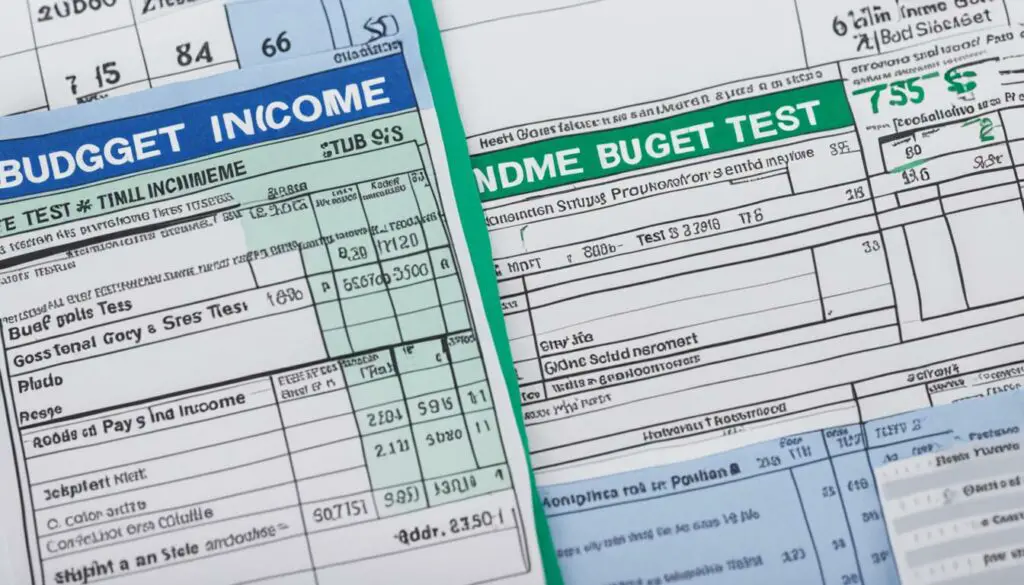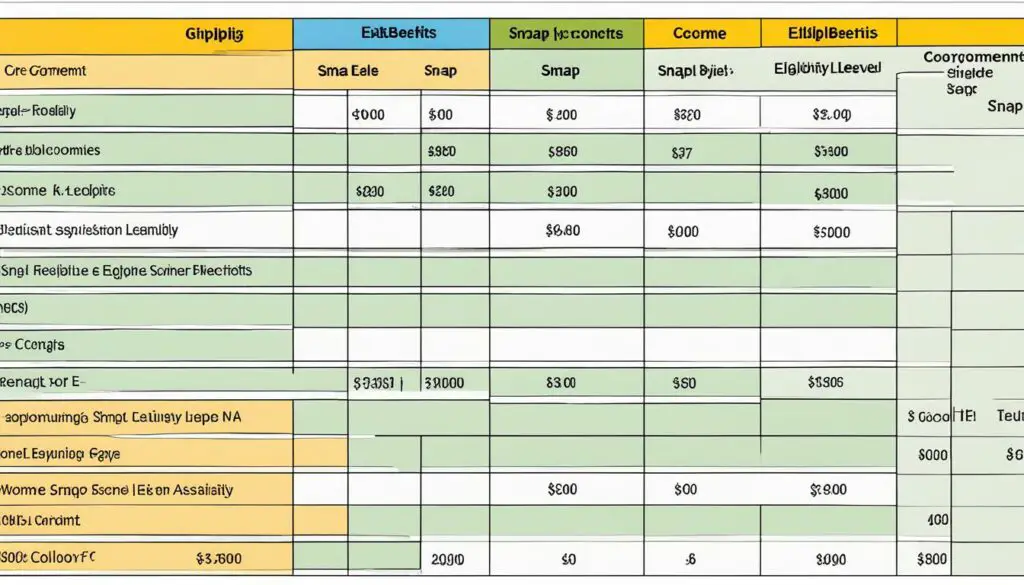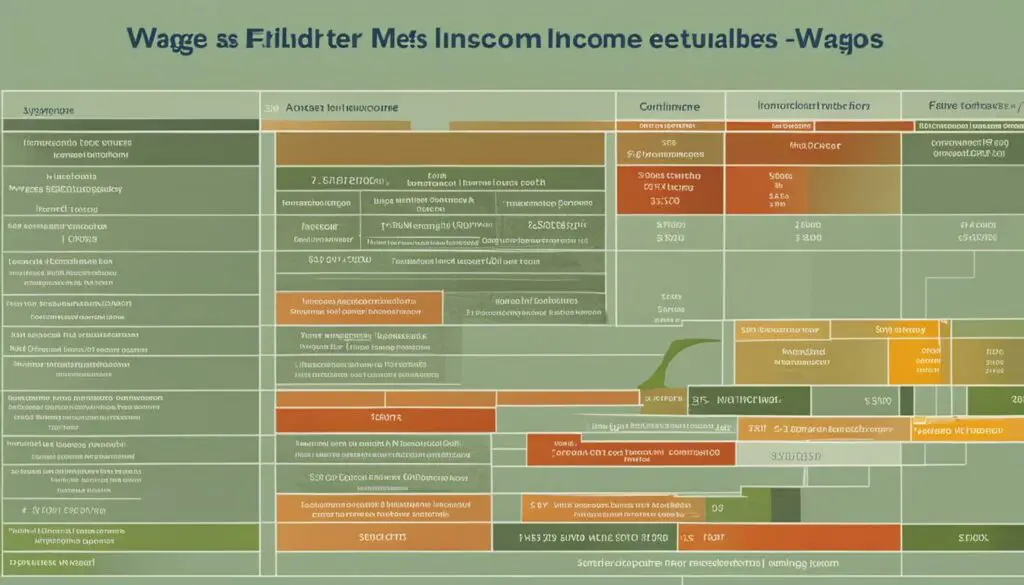Originally posted on December 20, 2023 @ 4:32 pm
Welcome to our comprehensive guide on the income limits for food stamps in Georgia for the year 2023. If you’re wondering about the eligibility criteria and income guidelines for receiving GA food stamps, you’ve come to the right place. In this guide, we’ll break down the United States Department of Agriculture and Georgia Department of Human Service’s Division of Family and Children Services guidelines. By understanding these income limits, you can determine if you qualify for food stamp benefits and how to apply.
Table of Contents
Key Takeaways:
- Learn the income limits for food stamps in Georgia for the year 2023.
- Understand the gross and net income tests for SNAP eligibility.
- Discover the specific income limits based on household size.
- Find out how to calculate net income for SNAP benefits.
- Explore the allowable deductions for food stamp eligibility.
Gross Income Test and Net Income Test

In order to qualify for SNAP benefits in Georgia, applicants must meet the gross income test and the net income test. These tests are based on the SNAP eligibility guidelines set by the United States Department of Agriculture.
The gross income test assesses the total household income before any deductions. It includes earnings from work, self-employment, rental income, and other sources. To determine eligibility, the household’s gross income must be below a certain threshold based on the household size. This threshold takes into account the Federal Poverty Guidelines.
The net income test considers the gross income minus allowable expenses and deductions. It helps determine the household’s disposable income available for purchasing food. Allowable deductions include standard deductions, dependent care expenses, excess shelter costs, medical expenses for elderly or disabled members, and legally owed child support payments.
Most households are required to meet both the gross income test and the net income test. However, households with elderly individuals or receiving certain disability payments only need to meet the net income test.
The specific income limits for the gross income test and the net income test vary based on the size of the household. These limits are adjusted annually to account for changes in the cost of living.
“To qualify for SNAP benefits in Georgia, applicants must meet both the gross income test and the net income test. These tests help determine the household’s eligibility based on their income and allowable deductions.”
Understanding the gross income test and the net income test is crucial in determining SNAP eligibility in Georgia. It ensures that assistance is provided to those who truly need it, based on their household income and expenses.
Key Points:
- The gross income test assesses the total household income before deductions.
- The net income test considers the gross income minus allowable expenses and deductions.
- Most households need to meet both tests, while some households only need to meet the net income test.
- The income limits for these tests vary based on household size and are adjusted annually.
Georgia SNAP Income Eligibility Chart (2023)

The Georgia SNAP Income Eligibility Chart provides the maximum monthly net and gross income limits based on household size. This chart is essential for determining if your household is eligible for food stamp benefits in Georgia.
Here is the Georgia SNAP Income Eligibility Chart for the fiscal year 2024:
| Household Size | Maximum Gross Monthly Income Limit | Maximum Net Monthly Income Limit |
|---|---|---|
| 1 | $1,383 | $1,064 |
| 2 | $1,868 | $1,437 |
| 3 | $2,353 | $1,810 |
| 4 | $2,839 | $2,184 |
| 5 | $3,324 | $2,557 |
| 6 | $3,809 | $2,930 |
| 7 | $4,295 | $3,304 |
| 8 | $4,780 | $3,677 |
| Each additional member | + $486 | + $373 |
By identifying your household size in the chart, you can easily determine the maximum income limit for your household. It is crucial to compare your household’s gross and net monthly income to the respective limits to ascertain eligibility for food stamp benefits in Georgia.
Remember, meeting the income eligibility requirements is just one part of the SNAP application process. For a complete understanding of SNAP benefits and how to apply, continue reading the rest of our guide.
Get the support you need
Applying for food stamp benefits can be a complex process. Our comprehensive guide will help you navigate the eligibility criteria, application process, and more. Stay tuned for the next section, where we’ll discuss how to calculate net income for SNAP benefits in Georgia.
Calculating Net Income

To determine the net income for SNAP benefits in Georgia, it’s important to understand how to calculate it accurately. Net income is calculated by subtracting eligible deductions from the gross income. By following these steps, you can determine your monthly net income for food stamps:
- Start with Gross Income: Begin by calculating your gross income, which includes all sources of income from all household members. This can include wages, self-employment income, Social Security benefits, and more.
- Apply Earned Income Deduction: Deduct 20% of your earned income from the gross income. This earned income deduction is designed to account for work-related expenses.
- Consider Standard Deductions: Apply the standard deduction based on your household size. The standard deduction is a fixed amount that decreases your gross income.
- Factor in Dependent Care Deductions: If you incur expenses for child or dependent care, deduct those costs from your gross income.
- Account for Medical Expenses: If you have elderly or disabled household members, deduct their out-of-pocket medical expenses from your gross income.
- Subtract Legally Owed Child Support Payments: Deduct any legally owed child support payments that you make from your gross income.
- Consider Shelter Costs: If you are homeless or live in a shelter, you may be eligible for a deduction on your shelter costs.
- Deduct Excess Shelter Costs: If your shelter costs exceed 50% of your net income after the previous deductions, you may be eligible for an additional deduction.
By following these steps and subtracting all eligible deductions from your gross income, you will arrive at your net income for food stamps. This calculation is crucial in determining your eligibility for SNAP benefits in Georgia.
“Calculating net income accurately is vital when applying for SNAP benefits. By deducting eligible expenses from your gross income, you can determine your monthly net income and ensure you meet the income requirements.”
Simplified Example
To help illustrate how to calculate net income, let’s consider an example:
| Income Category | Amount |
|---|---|
| Gross Income | $2,500 |
| 20% Earned Income Deduction | -$500 |
| Standard Deduction | -$200 |
| Dependent Care Deduction | -$100 |
| Elderly/Disabled Medical Expenses | -$50 |
| Legally Owed Child Support Payments | -$150 |
| Shelter Costs Deduction | -$75 |
| Excess Shelter Costs Deduction | $0 |
| Net Income | $1,425 |
In this example, the household’s gross income is $2,500. After deducting the eligible expenses, the net income for their SNAP benefits calculation is $1,425.
Key Takeaways
- Net income is calculated by subtracting eligible deductions from the gross income.
- Allowable deductions for SNAP benefits in Georgia include earned income deduction, standard deductions, dependent care deductions, deductions for elderly or disabled members’ medical expenses, legally owed child support payments, homeless household’s shelter costs deduction, and deductions for excess shelter costs.
- Follow the step-by-step calculation process outlined in this section to accurately determine your net income for SNAP benefits.
Georgia SNAP Standard Deduction and Allowable Deductions

The Georgia SNAP program provides various deductions to determine the net income for eligible households. These deductions play a crucial role in calculating the amount of assistance individuals and families may receive. In this section, we will explore the standard deduction based on household size and location, as well as other allowable deductions that can help reduce the net income.
Standard Deduction Amounts
The Georgia SNAP program offers standard deductions for different household sizes and locations. These deductions are subtracted from the total income to calculate the net income. Here are the standard deduction amounts for 2023:
| Household Size | Standard Deduction Amount |
|---|---|
| 1 | $160 |
| 2 | $285 |
| 3 | $405 |
| 4 | $510 |
| 5 | $614 |
The standard deduction amount increases with each additional household member. It is important to note that these deductions are subject to change, so it is recommended to refer to the official guidelines provided by the Georgia Department of Human Service’s Division of Family and Children Services for the most up-to-date information.
Other Allowable Deductions
In addition to the standard deduction, Georgia SNAP also allows for other deductions to further reduce the net income. These deductions include:
- Earned Income Deduction: A 20% deduction from earned income to account for work-related expenses.
- Dependent Care Deduction: Deductions for child or dependent care expenses incurred to enable a household member to work.
- Medical Expense Deduction: Deductions for medical expenses paid by elderly or disabled household members.
- Excess Shelter Costs Deduction: Deductions for households with high shelter costs that exceed a certain percentage of their income.
These additional deductions can significantly impact the net income, potentially increasing eligibility for SNAP benefits. It is important to gather relevant documentation and receipts to support these deductions during the application process.
Understanding the standard deduction and allowable deductions is key to determining the net income for SNAP benefits in Georgia. By deducting these amounts from the total income, individuals and families can have a clearer understanding of their eligibility and the level of assistance they may receive.
Applying for Georgia Food Stamps

Applying for Georgia food stamps is a straightforward process that ensures individuals and families in need can access the necessary assistance. Whether you prefer to apply online, by mail, or in-person at a local county Division of Family and Children Services (DFCS) Office, Georgia provides multiple options to accommodate your preferences.
To apply online, visit the official Georgia Gateway website and complete the SNAP application. This secure online platform allows you to conveniently submit your application from the comfort of your own home. Make sure to have all the required documents ready, including proof of identity, residency, income, and expenses.
If you prefer to apply by mail, you can request a paper application by contacting your local county DFCS Office. Fill out the application form accurately and include copies of the necessary documents. Once completed, mail the application to the designated address provided by the DFCS Office.
If you’re more comfortable with in-person assistance, visit your local county DFCS Office to apply for Georgia food stamps. During your visit, a representative will guide you through the application process, ensuring you have all the required forms and documents readily available. This option allows for any questions or concerns to be addressed promptly.
“Applying for Georgia food stamps is a straightforward process that ensures individuals and families in need can access the necessary assistance.”
Required Forms and Documents
When applying for Georgia food stamps, it’s essential to have the required forms and documents readily available. This ensures a smooth and efficient application process. The following are some of the documents you may need:
- Proof of identity for all household members
- Proof of residency, such as a utility bill or lease agreement
- Social Security numbers for all household members
- Proof of income, including recent pay stubs, unemployment benefits, or self-employment records
- Proof of expenses, such as rent or mortgage payments, utility bills, child support, and dependent care expenses
- Proof of medical expenses for elderly or disabled household members
It’s important to note that additional documentation may be required based on your specific circumstances. Contact your local county DFCS Office for a complete list of required forms and documents.
Eligibility Interview
As part of the application process, you may be required to participate in an eligibility interview. This interview allows the DFCS representative to gather more information about your household and verify the details provided in your application. During the interview, be prepared to answer questions about your income, expenses, household composition, and any other relevant information. The interview can be conducted in person, over the phone, or through a video call, depending on your preference and circumstances.
Remember that transparency and accuracy are crucial throughout the application process. Providing complete and truthful information ensures that your application is processed accurately and efficiently.
Image Alt Tag: How to Apply for Georgia Food Stamps
SNAP Benefit Amount in Georgia

The amount of SNAP benefits an eligible household receives in Georgia is based on the household size. The Georgia SNAP program provides a maximum benefit allotment for each household size. By referring to the chart below, individuals can determine the maximum amount of assistance they may receive based on the number of people in their household.
| Household Size | Maximum SNAP Benefit Amount |
|---|---|
| 1 | $234 |
| 2 | $430 |
| 3 | $616 |
| 4 | $782 |
| 5 | $929 |
| 6 | $1,114 |
| 7 | $1,232 |
| 8 | $1,408 |
| Each additional member | + $176 |
To determine the specific amount of SNAP benefits for a household, individuals should identify their household size and refer to the corresponding maximum benefit amount in the chart. It’s important to note that this chart provides the maximum benefit allotments, and actual benefit amounts may vary based on an individual’s income and specific circumstances.
Fig. 1: Maximum SNAP Benefit Amounts in Georgia based on Household Size
Snap Household and Resource Requirements
To qualify for SNAP benefits in Georgia, applicants must meet specific requirements concerning their household composition and available resources. This section provides an overview of the SNAP household requirements and resource limits for eligibility.
Snap Household Requirements
A SNAP household includes individuals who live together and share meals. The following individuals are considered part of a SNAP household:
- Parents and their children under the age of 22
- Spouses
- Individuals who purchase and prepare meals together
- Unmarried individuals who live together and share meals
It is important to note that roommates and boarders who do not share meals are not considered part of a SNAP household.
Snap Resource Limits in Georgia
To be eligible for SNAP benefits, households must meet resource limits, including both countable resources and exclusions. Countable resources refer to assets that can be converted into cash, while exclusions are resources that are not considered when determining eligibility.
The resource limits for SNAP eligibility in Georgia are as follows:
| Household Size | Resource Limit |
|---|---|
| 1 | $2,250 |
| 2 | $3,500 |
| 3 | $3,500 |
| 4 | $4,000 |
| 5 | $4,500 |
| 6 | $5,000 |
| 7 | $5,500 |
| 8+ | $5,500 + $750 for each additional member |
Countable resources may include:
- Cash
- Bank accounts
- Stocks
- Bonds
- Property that is not the household’s primary residence
On the other hand, some resources are excluded and do not count towards the resource limits. These exclusions might include:
- The household’s primary residence
- One vehicle used for daily transportation
- Retail food stores, such as grocery stores or supermarkets
- Retirement and pension plans
It is crucial for applicants to understand these requirements and assess their eligibility before applying for SNAP benefits in Georgia.
Conclusion
In conclusion, this comprehensive guide has provided a detailed overview of the income limits for food stamps in Georgia for the year 2023. We have explored the gross and net income tests, the Georgia SNAP income eligibility chart, how to calculate net income, allowable deductions, and the application process.
By understanding these guidelines, individuals can assess their eligibility for food stamp benefits and access the necessary resources to apply. It is crucial to consider household size, income categories, and the specific income limits set by the United States Department of Agriculture and the Georgia Department of Human Service’s Division of Family and Children Services.
If you or someone you know meets the income requirements outlined in this guide, applying for Georgia food stamps can provide much-needed assistance for accessing healthy and nutritious food for you and your family. Familiarizing yourself with the income limits and the application process can help streamline the application and ensure a smooth transition to receiving the benefits you are eligible for.
FAQ
What are the income limits for food stamps in Georgia in 2023?
The income limits for food stamps in Georgia vary based on household size. You can refer to the Georgia SNAP Income Eligibility Chart for the maximum monthly net and gross income limits.
What is the difference between the gross income test and the net income test for SNAP benefits in Georgia?
The gross income test is the total income of the household before any deductions, while the net income test is the gross income minus allowable expenses and deductions.
How do I calculate the net income for SNAP benefits in Georgia?
To calculate net income, subtract eligible deductions from your gross income. These deductions include a 20% deduction from earned income, standard deductions based on household size, dependent care deductions, deductions for elderly or disabled members’ medical expenses, legally owed child support payments, homeless household’s shelter costs deduction, and deductions for excess shelter costs.
What are the allowable deductions for SNAP benefits in Georgia?
Allowable deductions for SNAP benefits in Georgia include deductions for earned income, dependent care, medical expenses, and excess shelter costs.
How can I apply for Georgia food stamps?
You can apply for Georgia food stamps online, by mail, or in-person at a local county Division of Family and Children Services (DFCS) Office. The application will require certain forms, documents, and an eligibility interview.
How much SNAP benefits can I receive in Georgia?
The amount of SNAP benefits a household receives in Georgia is determined by the size of the household. You can refer to the chart provided to find out the maximum SNAP benefit allotment for each household size.
What are the household composition and resource requirements for SNAP benefits in Georgia?
Household composition requirements for SNAP benefits in Georgia determine who is considered part of a SNAP household. Resource limits include countable resources and exclusions such as vehicles, homes, and retirement plans.
Source Links
- https://igeorgiafoodstamps.com/income-limit-for-ga-food-stamps/
- https://igeorgiafoodstamps.com/georgia-food-stamps-income-limit/
- https://www.fns.usda.gov/snap/recipient/eligibility
See also:
Leave a Reply